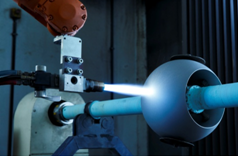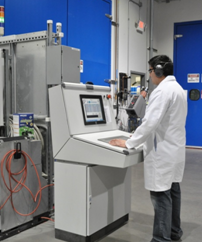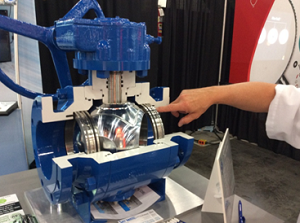Robots and Valves: A Good Match?
While the science fiction image of robots conjures up visions of humanoid-like machines with arms, legs and a head, the reality is that most robots have no resemblance at all to humans.
#automation
These advances, in addition to lower cost of acquisition, means that more industries can take advantage of this trend. In a recent poll conducted by Pricewaterhouse Coopers (PwC), 94% of CEOs who have already adopted robotics replied the move had increased productivity within their companies, and 64% said robotics will bring new innovations to their business models. Over the next five years, CEOs expect a fifth of their workforces to have some element of robotics to them, while 58% expect to reduce headcount in this period because of robotics, according to the PwC survey.
According to The Robotics Industry Association, a total of 6,895 robots valued at approximately $435.1 million were ordered from North American companies during the first quarter of 2015. While automotive continues to utilize them most, other growth areas supporting the valve industry are metals at 7%, material handling (33%), spot welding (26%), and coating and dispensing (9%). This leads to the big question: How much will robotics replace workers versus augmenting a company's workforce?
A general fear persists as to the extent to which robotics and computerization will impact the workforce, and it may bear some validity as 69% of CEOs polled in the PwC survey agreed that robotics will make some repetitive task jobs obsolete. However, manufacturers also see robotics technology as generating new high-skilled job opportunities for humans to engineer advanced robotics and systems, and to work with those robots in the field.
To get a feel for the extent to which robotics are being utilized in this industry, VALVE Magazine spoke to a few members of the Valve Manufacturers Association.
Robotics in Valve Manufacturing
Welding and casting are the most likely places to use robotics in the manufacturing of components of valves.
“Robots are not such a great fit for the kind of manufacturing we do,” said Ian Barnes of Chesterton. “Ours are generally high complexity, unique sealing and packing products made for specific projects, so the volume is low. It would be difficult to justify robotics for this kind of task."
Rob Kukowski, CEO of Matrix Metals, said his company is not using robotics yet, but he does see the possibilities for the future. He also mentioned that the Chinese are beginning to use robots because, despite reports of slowing growth, a huge percentage of manufacturing is in that country and they are planning for a time when there will not be enough workers to manage it. "In two years," he said, "I envision that they will be using robots more than in Germany."
Germany does indeed utilize robots in many areas. Ron Hendricks, manager of business development for KITZ’s southwest region of the U.S., said that his company's German group, Perrin, uses many robots. "Thermal spray coating is done in a vacuum chamber by robots in our plant in Germany,” he said. “And at one time, in our KITZ plant in Suwa, Japan, robots were making 1.2 million small brass valves per month. They were manufactured without any human hands touching them! KITZ does employ robotics extensively in the manufacturing of its bronze/brass and iron products.”
Larry Woodworth, industrial product manager at Val-Matic, explained that, while it might be possible for many of the components of valves to be manufactured by robots, the complexity of some valves would make it basically impossible to assemble without humans. "Look at the confined spaces, and there is no direct line of site. Of course, while the machining of parts could be done by robots, it takes human hands to put the seals and gaskets in the right place. We build these from the inside out,” he said. “The complexity is incredible."
Distribution
While the high cost of purchasing, programming and adapting the facility to adapt to robotics may inhibit adoption in valve distribution, there definitely is a business case to be made for the investment. “Automation drives more efficiency, improves performance, reduces processing time and lower costs for distribution operations,” says Ken Ruehrdanz, distribution systems market manager of logistics innovator Dematic.
For consumer goods, the automotive industry and pharmaceuticals, robots have been used with good results. However, in surveying several valve distributors, we were unable to find any who currently use robotics in their facilities. If your distribution operation is taking advantage of this technology, please let us know how you have been able to utilize robotics in your facility.
Robotic Inspectors
Back in December of 2014, GE Hitachi Nuclear Energy used this ultrasonic robot, Surveyor, to successfully inspect a section of underground pipe at the South Texas Project Electric Generating Station. The articulated robot used a single access point to inspect approximately 30 feet of an aluminum-bronze alloy service water pipe with a 6-inch diameter. It inspected a 10-foot vertical section, negotiated a 90-degree elbow and then inspected a 20-foot horizontal section.
According to the company, the internal diameter inspection was completed in less than eight hours and required no modification to the piping system. By contrast, inspections performed with other solutions outside of the pipe itself require time-consuming excavation that could cost up to hundreds of thousands of dollars. While outside-based inspections are limited to the exposed length of pipe, the robot can inspect an entire length of pipe.
Considering Robotics
When a supplier, manufacturer or distributor is considering the possibility of adopting robotics, it is important to work with an integrator who can match its technology with the needs of the company. When mindful of the ways these devices can be incorporated into the existing structure and workforce, companies have found that robots can do much more than replace workers: They can help make employees more efficient and have greater job satisfaction while increasing safety, productivity and efficiencies.
Kate Kunkel is senior editor of VALVE Magazine. Reach her at kkunkel@vma.org.
RELATED CONTENT
-
The Final Control Element: Controlling Energy Transformation
When selecting control valves, be sure to properly evaluate the process conditions to identify potential issues and select the proper management techniques.
-
Which Gate Valve is Best for Today's Waterworks Systems?
A historical perspective may provide the answer.
-
Erosive Pulp & Paper Systems Require Proper Valve Selection
As new recycled paper plants are being built for the first time in decades, not only do paper companies have opportunities to grow revenue but so do service suppliers such as valve companies.












 Unloading large gate valve.jpg;maxWidth=214)


